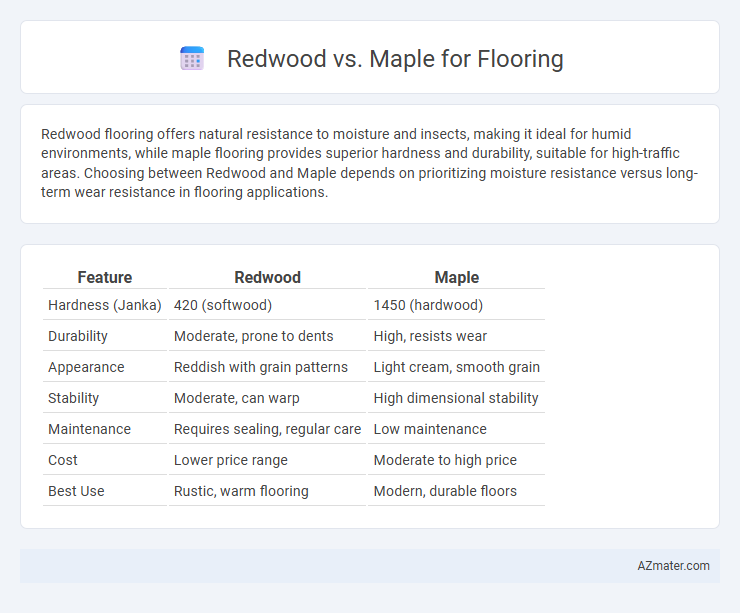Redwood flooring offers natural resistance to moisture and insects, making it ideal for humid environments, while maple flooring provides superior hardness and durability, suitable for high-traffic areas. Choosing between Redwood and Maple depends on prioritizing moisture resistance versus long-term wear resistance in flooring applications.
Table of Comparison
| Feature | Redwood | Maple |
|---|---|---|
| Hardness (Janka) | 420 (softwood) | 1450 (hardwood) |
| Durability | Moderate, prone to dents | High, resists wear |
| Appearance | Reddish with grain patterns | Light cream, smooth grain |
| Stability | Moderate, can warp | High dimensional stability |
| Maintenance | Requires sealing, regular care | Low maintenance |
| Cost | Lower price range | Moderate to high price |
| Best Use | Rustic, warm flooring | Modern, durable floors |
Overview: Redwood vs Maple Flooring
Redwood flooring offers a warm, rich reddish hue with natural resistance to decay and insect damage, making it ideal for both indoor and outdoor applications. Maple flooring is highly durable, featuring a fine, consistent grain and light creamy color that brightens spaces while withstanding heavy foot traffic. Both woods provide unique aesthetic and functional benefits, with redwood excelling in moisture resistance and maple known for its hardness and wear resistance.
Wood Characteristics and Aesthetics
Redwood flooring features a warm reddish hue and straight grain with occasional knots, offering a durable yet soft surface ideal for low-traffic areas. Maple exhibits a lighter cream to reddish-brown color with a smooth, fine grain, providing high hardness and resistance to wear, making it suitable for high-traffic spaces. Both woods offer distinct aesthetics--redwood's rustic, natural charm contrasts with maple's clean, contemporary look--allowing versatile design choices based on durability and style preferences.
Durability and Hardness Comparison
Redwood flooring offers moderate durability with a Janka hardness rating of approximately 420, making it softer and less resistant to dents compared to maple, which boasts a Janka rating of about 1450, indicating superior hardness and durability. Maple's high density contributes to its excellent resistance against wear, scratches, and heavy foot traffic, ideal for areas subject to frequent use. Redwood's softness provides comfort underfoot but requires more maintenance and care to avoid damage in high-traffic environments.
Color and Grain Differences
Redwood flooring exhibits a rich reddish-brown hue with natural variations that deepen over time, contrasting with maple's lighter cream to pale reddish-brown tones that offer a more uniform appearance. The grain of redwood is typically straight with occasional knots and a coarse texture, providing a rustic and warm aesthetic. In comparison, maple features a fine, consistent grain pattern with subtle waves, resulting in a smooth and elegant finish ideal for contemporary interiors.
Maintenance and Cleaning Requirements
Redwood flooring requires minimal maintenance due to its natural resistance to moisture and decay, making it easy to clean with regular sweeping and occasional damp mopping. Maple floors demand more frequent care to prevent scratches and dents, often needing specialized hardwood cleaners and refinishing over time to maintain their appearance. Both wood types benefit from protective measures like using rugs and furniture pads to extend longevity and preserve their surface quality.
Cost and Affordability
Redwood flooring typically costs between $7 and $12 per square foot, making it a mid-range option, while maple flooring ranges from $6 to $10 per square foot, often providing a more affordable choice. Redwood is prized for its durability and natural resistance to moisture, which can reduce long-term maintenance expenses, but initial installation prices tend to be higher. Maple's dense grain offers strong wear resistance and abundant availability, contributing to lower upfront costs and widespread affordability for flooring projects.
Sustainability and Environmental Impact
Redwood flooring is highly sustainable due to its rapid growth rate and carbon sequestration capabilities, making it a renewable resource with a lower environmental footprint. Maple, while durable and long-lasting, grows more slowly and requires more intensive harvesting practices that can contribute to deforestation and habitat disruption. Choosing redwood supports eco-friendly forestry management and reduces carbon emissions compared to the less sustainable harvesting cycles associated with maple.
Installation Considerations
Redwood flooring requires careful moisture control and acclimation before installation due to its natural softness and susceptibility to warping, while maple demands precise subfloor preparation because of its hardness and density. Both woods benefit from professional installation techniques such as proper nailing or gluing methods to ensure stability and longevity. Installation time may be longer for maple because of specialized tools needed to cut and shape the dense fibers compared to the softer Redwood.
Suitability for Different Rooms
Redwood flooring offers excellent moisture resistance, making it highly suitable for bathrooms, kitchens, and basements where humidity levels vary. Maple, known for its hardness and durability, is ideal for high-traffic areas such as living rooms, hallways, and dining rooms, providing long-lasting wear. Both woods bring unique aesthetics, but selecting based on room function ensures optimal performance and longevity.
Pros and Cons Summary
Redwood flooring offers exceptional durability and natural resistance to decay, making it ideal for moisture-prone areas, but it tends to be softer and more prone to dents compared to harder woods. Maple flooring provides a hard, dense surface known for its excellent scratch resistance and smooth grain, but it can be more expensive and less resistant to moisture damage. Both woods vary in color and grain patterns, with redwood showcasing rich reddish hues and organic knots while maple displays a lighter, more uniform appearance suited for modern interiors.

Infographic: Redwood vs Maple for Flooring
 azmater.com
azmater.com